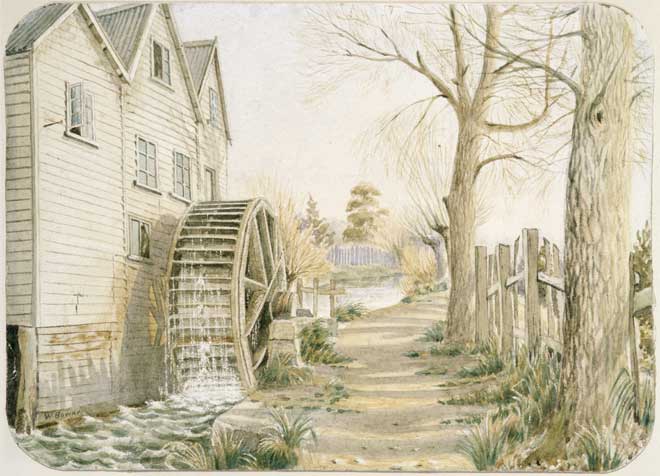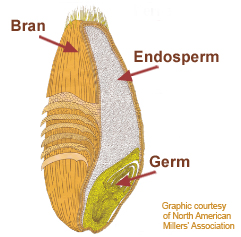Brown flour just ain't what is is cracked up to be. Let me quote a paragraph or two from The Third Plate by Dan Barber (incidentally, highly recommended)
"The roller mill appeared in the late 1800's just in time to expand the divide between the wheat field and the table. It was a technological breakthrough that revolutionized the wheat industry just as the cotton gin had done for the cotton industry a century earlier. Until its widespread use, people used stone mills. Stone mills like the one we use at Blue Hill work like molars, crushing the kernels between two large stones. They are effective, but slow and tedious, and they do little to separate the kernel into its component parts, a key development in the drive to industrialize flour.

A few years ago, Klaas's wife, Mary-Howell showed me a picture of a wheat kernel in cross section. It looked like an ultrasound image of a six-or seven week old human gestational sac, which isnt a bad comparison; a wheat kernel is a seed, after all. The grain's embryo or 'germ' is surrounded by the starchy endosperm, - the stuff of refined white flour - which stores food for the germ. Surrounding the endosperm is the seed coat or bran, which protects the germ until moisture and heat levels indicate it's time to germinate.

Whereas stone mills had crushed the tiny germ, releasing oils that would turn the flour rancid within days, roller mills separated the germ and the bran from the endosperm. This new ability to isolate the endosperm allowed for the production of self-stable white flour, able to be stored and transported long distances. Overnight, flour became a commodity.

It's hard to fathom that merely removing a temperamental little germ could revolutionize a staple grain, but that's just what happened. The settling of the Great Plains and the advent of roller-mill technology meant that white flour was suddenly cheaper and more readily available. Small wheat farms, including those in the former grain belt of New York, couldn't compete. Gristmills dotting the landscape became the stuff of folklore. The homogenization of the US wheat industry had begun
The whiter flour became, the greater the demand. To be fair, that's been the history of wheat for thousands of years. But for all its efficiency, steel couldn't match the old-school grindstone in two key respects. In fully removing the germ - that vital, living element of wheat - and the bran, the roller mill not only killed wheat but also sacrificed nearly all of its nutrition. While the bran and the germ represent less than 20% of a wheat kernel's total weight, together they comprise 80% of it's fiber and other nutrients. And studies show that the nutritional benefits of whole grains can be gained only when all the edible parts of the grain - bran, germ and endosperm - are consumed together*. But that's exactly what was lost in the new milling process.
*this probably relates to the fact that you need to consume all the amino acids in protein at the same time. The digestive system takes up amino acids as balanced proteins. If there is an excess of one amino acid, the excess is rejected. Presumably there are different amino acids in the various components of the wheat seed and only by consuming the whole seed do you get the full nutrition.
There was another cost as well, just as devastating. Stone-milled flour retained a golden hue from the crushed germ's oil and was fragrant with bits of nutty bran. The roller mills might have finally achieved a truly white flour, but the dead chalky powder no longer tasted of wheat - or really of anything at all. We didn't just kill wheat, We killed the flavor.
"The roller mill appeared in the late 1800's just in time to expand the divide between the wheat field and the table. It was a technological breakthrough that revolutionized the wheat industry just as the cotton gin had done for the cotton industry a century earlier. Until its widespread use, people used stone mills. Stone mills like the one we use at Blue Hill work like molars, crushing the kernels between two large stones. They are effective, but slow and tedious, and they do little to separate the kernel into its component parts, a key development in the drive to industrialize flour.

A few years ago, Klaas's wife, Mary-Howell showed me a picture of a wheat kernel in cross section. It looked like an ultrasound image of a six-or seven week old human gestational sac, which isnt a bad comparison; a wheat kernel is a seed, after all. The grain's embryo or 'germ' is surrounded by the starchy endosperm, - the stuff of refined white flour - which stores food for the germ. Surrounding the endosperm is the seed coat or bran, which protects the germ until moisture and heat levels indicate it's time to germinate.

Whereas stone mills had crushed the tiny germ, releasing oils that would turn the flour rancid within days, roller mills separated the germ and the bran from the endosperm. This new ability to isolate the endosperm allowed for the production of self-stable white flour, able to be stored and transported long distances. Overnight, flour became a commodity.

It's hard to fathom that merely removing a temperamental little germ could revolutionize a staple grain, but that's just what happened. The settling of the Great Plains and the advent of roller-mill technology meant that white flour was suddenly cheaper and more readily available. Small wheat farms, including those in the former grain belt of New York, couldn't compete. Gristmills dotting the landscape became the stuff of folklore. The homogenization of the US wheat industry had begun
The whiter flour became, the greater the demand. To be fair, that's been the history of wheat for thousands of years. But for all its efficiency, steel couldn't match the old-school grindstone in two key respects. In fully removing the germ - that vital, living element of wheat - and the bran, the roller mill not only killed wheat but also sacrificed nearly all of its nutrition. While the bran and the germ represent less than 20% of a wheat kernel's total weight, together they comprise 80% of it's fiber and other nutrients. And studies show that the nutritional benefits of whole grains can be gained only when all the edible parts of the grain - bran, germ and endosperm - are consumed together*. But that's exactly what was lost in the new milling process.
*this probably relates to the fact that you need to consume all the amino acids in protein at the same time. The digestive system takes up amino acids as balanced proteins. If there is an excess of one amino acid, the excess is rejected. Presumably there are different amino acids in the various components of the wheat seed and only by consuming the whole seed do you get the full nutrition.
There was another cost as well, just as devastating. Stone-milled flour retained a golden hue from the crushed germ's oil and was fragrant with bits of nutty bran. The roller mills might have finally achieved a truly white flour, but the dead chalky powder no longer tasted of wheat - or really of anything at all. We didn't just kill wheat, We killed the flavor.

